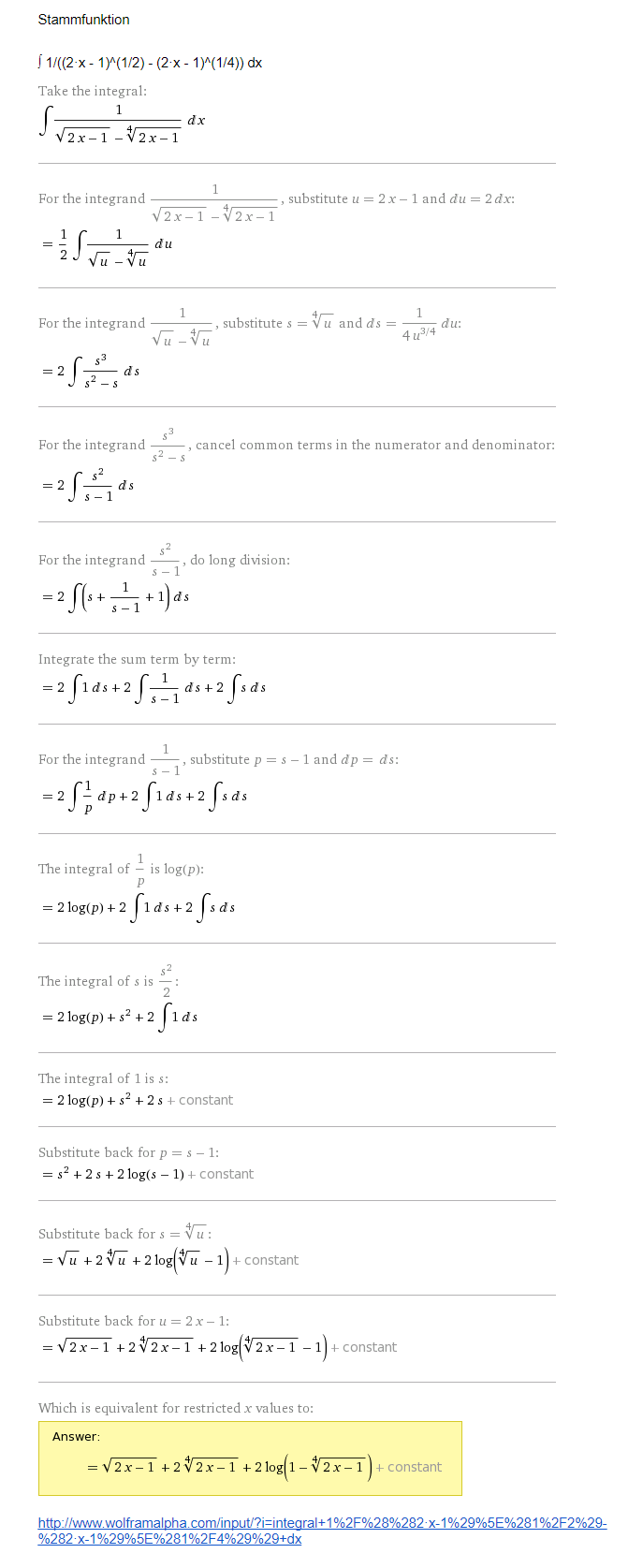Ja. Als Anfangssubstitution ist das gar nicht schlecht. Allerdings musst du hier öfter substituieren. Ich habe das mal von Wolframalpha lösen lassen.

Stammfunktion
\( \int 1 /\left((2 \cdot x-1)^{\wedge}(1 / 2)-(2 \cdot x-1)^{\wedge}(1 / 4)\right) d x \)
Take the integral:
\( \int \frac{1}{\sqrt{2 x-1}-\sqrt[4]{2 x-1}} d x \)
For the integrand \( \frac{1}{\sqrt{2 x-1}-\sqrt[4]{2 x-1}} \), substitute \( u=2 x-1 \) and \( d u=2 d x \) :
\( =\frac{1}{2} \int \frac{1}{\sqrt{u}-\sqrt[4]{u}} d u \)
For the integrand \( \frac{1}{\sqrt{u}-\sqrt[4]{u}} \), substitute \( s=\sqrt[4]{u} \) and \( d s=\frac{1}{4 u^{3 / 4}} d u \) :
\( =2 \int \frac{s^{3}}{s^{2}-s} d s \)
For the integrand \( \frac{s^{3}}{s^{2}-s} \), cancel common terms in the numerator and denominator:
\( =2 \int \frac{s^{2}}{s-1} d s \)
For the integrand \( \frac{s^{2}}{s-1} \), do long division:
\( =2 \int\left(s+\frac{1}{s-1}+1\right) d s \)
Integrate the sum term by term:
\( =2 \int 1 d s+2 \int \frac{1}{s-1} d s+2 \int s d s \)
For the integrand \( \frac{1}{s-1} \), substitute \( p=s-1 \) and \( d p=d s \) :
\( =2 \int \frac{1}{p} d p+2 \int 1 d s+2 \int s d s \)
The integral of \( \frac{1}{p} \) is \( \log (p) \) :
\( =2 \log (p)+2 \int 1 d s+2 \int s d s \)
The integral of \( s \) is \( \frac{s^{2}}{2} \) :
\( =2 \log (p)+s^{2}+2 \int 1 d s \)
The integral of 1 is \( s \) :
\( =2 \log (p)+s^{2}+2 s+\text { constant } \)
Substitute back for \( p=s-1 \) :
\( =s^{2}+2 s+2 \log (s-1)+\text { constant } \)
Substitute back for \( s=\sqrt[4]{u} \) :
\( =\sqrt{u}+2 \sqrt[4]{u}+2 \log (\sqrt[4]{u}-1)+\text { constant } \)
Substitute back for \( u=2 x-1 \) :
\( =\sqrt{2 x-1}+2 \sqrt[4]{2 x-1}+2 \log (\sqrt[4]{2 x-1}-1)+\text { constant } \)
Which is equivalent for restricted \( x \) values to:
Answer:
\( =\sqrt{2 x-1}+2 \sqrt[4]{2 x-1}+2 \log (1-\sqrt[4]{2 x-1})+\text { constant } \)
http://uww.wolframalpha.com/input/?i=integral \( +1 \% 2 \mathrm{~F} \% 28 \% 282 \cdot \mathrm{x}-1 \% 29 \% 5 \mathrm{E} \% 281 \% 2 \mathrm{~F} 2 \% 29 \) -
\( \% 282 \cdot \mathrm{x}-1 \% 29 \% 5 \mathrm{E} \% 281 \% 2 \mathrm{~F} 4 \% 29 \% 29+\mathrm{dx} \)
Solltest du fragen dazu haben dann melde dich gerne.
Man sollte sich aber öfter mal mit Wolframalpha beschäftigen.